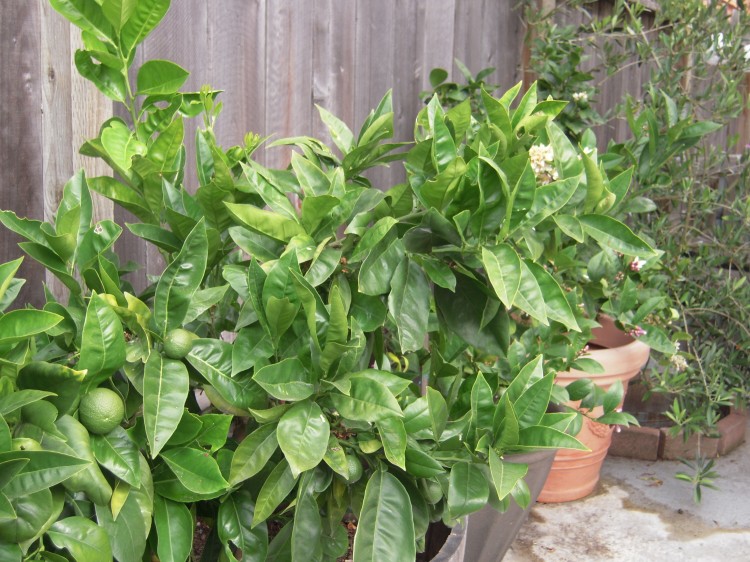
citrus trees in my backyard in large containers
Today I busied myself with citrus upkeep. I have three orange trees – one semi-dwarf and one standard planted in my side yard, and one dwarf in a container; two dwarf lime trees in containers; two dwarf lemon trees, one in a container and one in the ground; and one dwarf calamansi in the ground.
My backyard is a skinny, L-shaped affair with no grass, courtesy of this being a corner lot and the stupidity of former owners, respectively. Given the lack of actual ground to plant things in, I have an extensive container garden. Containers offer a number of challenges, but for citrus trees these are minimal, provided you have the right kind of container with the proper drainage and you keep on top of things, namely fertilizer, pruning and the correct amount of water. Use of the right soil from the get-go helps. I employ a good potting soil with some peat moss and sand added. Using half cactus mix with potting soil has also worked for me. You want a soil that is a bit lighter than potting soil and one that will hold moisture but not be overly wet or muddy after deep watering. Be sure you use a container that is wide enough and deep enough for the roots. You can plant a dwarf tree in a half-wine barrel and it will never outgrow it, and you can keep a semi-dwarf and even standard tree in them for a few years, if you need to, but I don’t like moving these guys unless I have to. I moved my Eureka lemon tree from a pot at my old place to the side yard of my current house in early 2007, and it only recovered in the last few months with quite a bit of TLC.
Drainage is key. Make sure you provide a bed of several inches of pea gravel, decent drainage holes that you cover with mesh before you put the gravel in (this keeps small pests out and soil in) and situate the tree according to the directions provided; many require some root exposure and a watering trough around the tree.
Citrus trees should be fed a diet that includes nitrogen and phosphorus. Personally, I do not apply as much citrus fertilizer as manufacturers recommend to ensure that my trees are not getting more nitrogen than is good for them (it would adversely affect the pH) and apply chelated iron when I see signs of iron deficiency, such as yellowing leaves. I fertilize every two months or so, year-round. Basically you need to look at your trees on a regular basis to gauge what you should be doing. Bottom line is that the pH of your soil should be between 6 and 8, with numerous agricultural sources indicating an optimal range of 5.5 – 6.5. If you are having problems with your trees the first thing you should do is check the pH!
In terms of pruning, if you do nothing else, make sure you remove suckers growing below the graftline on dwarf varieties. If you have dead branches, trim those off. You should not have many of them, but I had plenty on the lemon tree that I moved. You are also advised to train dwarf trees to produce better and larger fruit by selecting main growing branches and cutting back others. I generally do not do this unless the tree is unbalanced, because it’s a trade-off: I would rather have all the branches with their associated leaves serving as protection from the intense sunlight they are exposed to here. While sunlight is great for citrus, it can be a problem with young, spindly trees.
My trees produce very well, and I keep them in clusters for pollination. They are rarely attacked by bugs or disease, and if I have a little problem I take a clipping to my local nursery. My most challenging trees have been a dwarf Meyer lemon and the calamansi. The Meyer lemon is not looking as good as my other trees, but it is the newest and may still be recovering. The calamansi bears a tremendous number of fruit, but they are not as large as I think they should be, and is always suffering from iron deficiency.
I will add one more tree – a kaffir lime; I will then be in good shape.
